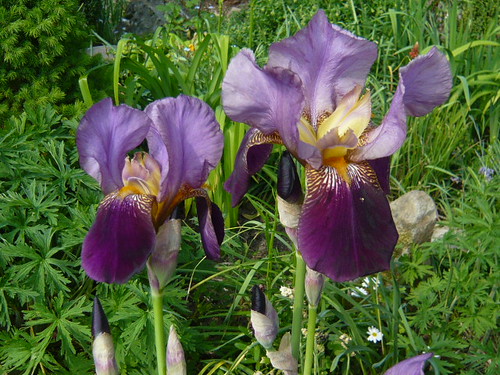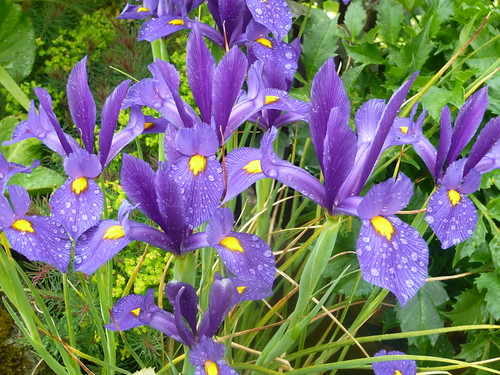Iris is the Rainbow Goddess
Iris flowers are named after the Greek Goddess of the rainbow, which is appropriate for their extensive range of colours.
There are many different varieties of Iris The most common is the German Bearded Iris’ which include a range of different cultivatars.
- Provided they are grown in a suitable location, Iris provide a good low maintenance display.
- The main thing is to ensure the soil has good drainage. If the bulbs become waterlogged there is a risk of the bulb rotting. (apart from the varieties which are grown on pond edges.
- Iris enjoy full sun or partial sun.
- The Iriz rhizomes should be planted at or just above soil level.
- Iris bulb varieties should be planted 2-3 times the depth of the bulb size.
- I. unguicularis is a good variety for offering flowers in early winter when flowers are rare. These need a sheltered, sunny and free draining spot.
Dividing Iris.
Iris can be divided every 2-3 years. It is best to this in autumn at the end of the growing season. It is fine to use a spade and split the rhizomes into 2 or 3 pieces.
Common Iris Problems.
- Slugs and Snails. Slugs are attracted to Iris especially the flowers. When the flowers fade it is helpful to remove the flowers and top third of the leaves to make the plants more attractive and also remove a lot of slugs who may remain at the top third of the plant
- Aphids are a spreader of disease and virus but Iris are more prone to problems of growing conditions. Make sure the species specific requirements are met.
- If a rhizome plant starts to show signs of ‘rot’ in spring cut away all signs of wet rot and the remaining rhizome can be replanted.
- Maintain good hygiene.
Read more about Iris on Gardeners Tips.

Growing Iris Aucheri and Junos
Iris aucheri is almost icy blue in its typical form, but can be white to blue with a yellow ridge on the falls. There is a deep indigo form as well. The flowers have a violet-like scent.
This plant is growing in an Alpine house but it is easy, hardy, and vigorous, preferring sun and well drained soil. Water may collect in the leaves causing rot.
It is one of the ‘Junos’ which make up the largest group of bulbous irises with something around 60 species.
The overall form of most Junos is very distinct with fleshy corn like stems.
These varieties are dormant in summer.
‘Long tom pots’ are best to accommodate the deep fleshy roots.
All Juno Iris are best grown from seed.
Other Juno Species
- Iris bucharica is the easiest and most widely grown of the Juno iris. It blooms and multiplies very well for me. It has relatively small roots
- Iris magnifica – This iris has a small bulb on top of large dahlia-like roots
- Iris vicaria is a more colourful magnifica with violet flowers.
- Iris nicolai will not take overhead watering so they have to be grown in a pot within a larger pot, watering the outside pot only.
- Iris cycloglossa is a tall and slender hardy blue with upright standards.
- Iris nicolai is a stunning dwarf species that need to be grown in a frame.
- Finally two Iris Aucheri hybrids Sindpur with Iris Galatica and Warlsind with Iris Warleyensi
Bibliography
- Books from the British iris society. … many
- Irises by Harry Randall. …
- Gardeners Guide to Growing Irises Geoff Stebbings
- Irises by James Parry. …
- A guide to species irises : their identification & culture. …
- The Japanese iris by Currier Mcewen. …
- The Siberian iris by Currier Mcewen. …
- Iris the classic bearded varieties by Claire Austin photography Clay Perry.



One thought on “Iris is the Rainbow Goddess”
Comments are closed.